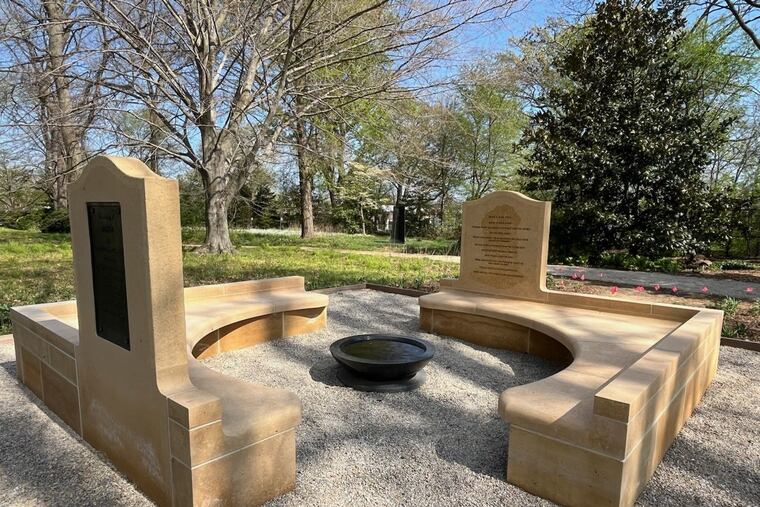At long last, the ‘Dinah’ memorial will be unveiled in Philadelphia’s Logan neighborhood
Nearly five years ago, Karyn Olivier was selected to design a monument to Dinah, a servant who saved the Stenton mansion from the British in 1777. The memorial will be unveiled on Saturday.

We don’t even know Dinah’s last name.
But on Saturday, Stenton, a colonial-era house museum in Logan, will unveil a new memorial to the Black woman known for outwitting the British during the Revolutionary War and saving the mansion from destruction.
Karyn Olivier, the Philadelphia sculptor who designed the new monument, was awarded the Rome Prize in 2018 and is a professor of sculpture at Temple University’s Tyler School of Art and Architecture.
Her “Dinah” design was chosen from among three finalists in 2019.
The only thing history recorded about Dinah was that she used her quick wits to save Stenton from British soldiers shortly after the Battle of Germantown.
A plain bronze plaque installed at the mansion in 1912 characterized Dinah as a “faithful colored caretaker” who “by her quick thoughts and presence of mind saved the mansion from being burned by British soldiers in the winter of 1777.”
Stenton, at 4601 N. 18th St., was built in 1730 by James Logan, who was William Penn’s secretary.
Dinah’s story has always been framed by the events of November 1777. She was alone at Stenton when two British soldiers banged on the door and told her they were going to set fire to the house. They then went off to the barn to gather straw.
At that point, a group of British troops rode up and asked Dinah if she had seen any deserters passing by. Her “quick thought,” as most tales about her conclude, led her to point the troops to the barn where they detained the would-be arsonists and took them away.
But Dennis Pickeral, Stenton’s executive director, said there was much more to Dinah’s life story than saving the mansion.
“We want to talk about her life in totality,” he said. “She gained her own freedom by requesting it.”
» READ MORE: Historic Stenton to honor enslaved housekeeper who saved the house from burning by the Brits
In planning the memorial, he said, Stenton staff began learning more about Dinah. They already knew she had been enslaved by Hannah Emlen Logan, the wife of William Logan, who was James Logan’s son and proprietor of Stenton, when Dinah lived there.
Logan family records show Dinah asked for her freedom and was emancipated on April 15, 1776, Pickeral said. However, she chose to remain as a paid caretaker.
Dinah, who had been separated from her husband because he was enslaved by another family, also asked the Logans to purchase him to reunite her family.
“So, there was so much more to her life, and her life was so much richer, than the fact that she was a ‘colored caretaker.’“
When questions become art
For Olivier, the absence of records about Dinah helped to shape her design.
Since there are no photographs or portraits of Dinah, Olivier’s monument includes a sculpted silhouette of a woman’s face engraved on limestone. It is set among curved benches surrounded by gardens and a small bird bath.
There are two tablets. One asks questions of Dinah: “What was your full name? When were you born and when did you die? How did freedom feel?”
The second tablet asks questions for visitors, such as: “Do you feel free?” “What are your wildest dreams?” “Would you have saved Stenton?”
Olivier said the monument allows people to have a conversation with Dinah that helps them reflect on what liberty means to them.
“I’m hoping we can speak about the link between the past to the present,” she said.
Just as Dinah had been enslaved, set free, but still remained a servant, Olivier noted that the mansion, which represents wealth, is located in a neighborhood with high degrees of poverty.
“It’s an invitation into the space where we can be intimate and vulnerable to allow for meditation in a beautiful setting surrounded by gardens.”
Olivier is also designer of the historical memorial project, Her Luxuriant Soil at Bethel Burial Ground in Queen Village.
» READ MORE: Winning design for the Bethel Burying Ground is called ‘spiritually and culturally ingenious’
» READ MORE: Artists to reveal how they will retell story of ‘Dinah,’ once known only as the ‘faithful colored caretaker’
The old 1912 plaque has been incorporated into the back of the monument. But Olivier has balanced the century-old description of Dinah with quotes by modern Black female writers.
From novelist Alice Walker: “Healing begins where the wound was made.” And from Lorraine Hansberry: “Never be afraid to sit awhile and think.”
Olivier said she chose Kasota limestone, the same stone used to build the Philadelphia Museum of Art “as a nod to Julian Abele, ” the Black architect who designed the museum, the Free Library of Philadelphia, and other notable buildings.
Stenton held a year-long process that included community members to help select Olivier.
The Pew Center for the Arts & Heritage supported the $500,000 project with a $360,000 grant. Constructions costs were about $250,000, Pickeral said. Stenton raised the rest of the money through donors and other funders.
He said Stenton had hoped to unveil the monument at least twice over the last couple of years, but the COVID-19 pandemic and problems acquiring the limestone delayed its completion until now.
The unveiling will be at 2 p.m. Saturday, April 20, at Stenton, 4601 N. 18th St. There will be poetry, drummers, and remarks by Karyn Olivier and neighborhood residents.
“I feel so honored and so proud of this memorial,” Olivier said. “It’s hard to make something that is both public, but that feels intimate and meditative, also.”